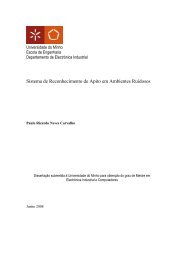Joel Nuno Silva Alves BIOSWIM - Implementação de rede de ...
Joel Nuno Silva Alves BIOSWIM - Implementação de rede de ...
Joel Nuno Silva Alves BIOSWIM - Implementação de rede de ...
Create successful ePaper yourself
Turn your PDF publications into a flip-book with our unique Google optimized e-Paper software.
Abstract<br />
This dissertation <strong>de</strong>scribes the <strong>de</strong>velopment of a wireless sensor network used by a<br />
biomedical signal monitoring system to be integrated in a swimsuit. The system will measure<br />
various biochemical, physiological and chemical performance parameters, to allow a global<br />
analysis of the behavior of the subject, as well as to signal abnormal behavior.<br />
Data communication consists of a body area network (BAN) materialized as a wireless<br />
network in two versions, one based on the 802.15.4 specification and another on the higher-level<br />
Zigbee protocol, <strong>de</strong>veloped using the Jennic JN5148 microcontroller, Jennics ZBPro stack and<br />
JenOs RT kernell. The system acquires, processes and sends signals from the sensors that will<br />
be connected. It is also composed of a graphical application on a computer that graphically<br />
represents the signals, controls the sensor no<strong>de</strong>s in terms of sampling rate and makes the<br />
recording and presentation of the errors that arise in communication.<br />
For <strong>de</strong>monstration purposes, a specific sensor for tympanic temperature measurement,<br />
of the thermistor type, was used, to measure this variable during sports activity. A specific<br />
conditioning circuit was <strong>de</strong>veloped and connected to a <strong>de</strong>vice no<strong>de</strong> in the wireless sensor<br />
network.<br />
The final system was tested with the <strong>de</strong>vices in different positions, as well as several<br />
sensor no<strong>de</strong>s communicating simultaneously. For each of the relative positions of the <strong>de</strong>vices the<br />
signal quality and frequency of communication errors were recor<strong>de</strong>d.<br />
The version implemented on basis of the Zigbee protocol was able to acquire and send<br />
sensor signals at a frequency of 7 kSamples/s (corresponding to a final net rate of 84 kbps) with<br />
a percentage of lost frames below 4%. It was also shown that the system supports simultaneous<br />
communication of three sensor no<strong>de</strong>s at 3 kS/s (36 kbps) each, with a percentage of losses of<br />
less than 4%.<br />
Keywords:<br />
Body Area Networks, BAN, Zigbee, 802.15.4, Electronic Textiles, Tympanic Temperature.<br />
V











